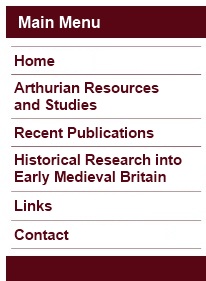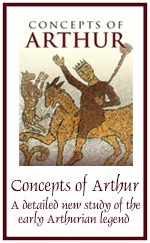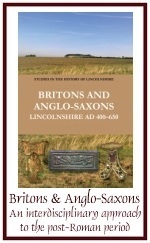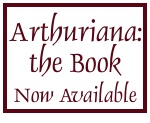
 |
 |
An
Arthurian FAQ: Some Frequently Asked Questions
1. Was there a historical Arthur? Yes, and no. If by Arthur you mean the person who supposedly led the British counter-attack against the Anglo-Saxons in the later 5th century, culminating in the famous Battle of Badon Hill, then the answer is simply 'yes'. Such a character did indeed exist – we have the evidence for his existence (and that of his most famous battle) in Gildas' De Excidio Britanniae, written c. 540 AD. However, if you mean something else then the answer is probably 'no'.
2. If the historical victor at Badon was called Arthur, where would he have been based? An interesting question. Many historians have preferred to place such a figure in southern Britain, on the basis of an assumption that this is where Badon was fought (usually it is equated with Bath or Badbury Rings). Many Celticists have preferred to place him in northern Britain, somewhere in the east between the River Humber and Edinburgh, on the basis of Y Gododdin and other legendary material. Many enthusiasts continue to place him in Cornwall, north Wales, Cumbria, Essex, Glasgow, Shropshire and almost anywhere else you can think of. The only possible way of locating such a 5th-century figure would be to use the battles listed in the Historia Brittonum, in particular the only one of these which can be confirmed as historical, Badon. This battle is, unfortunately, unlocated – all suggestions are more or less speculation, with there being little solid evidence available to go on. To quote J.N.L. Myres, 'the site of Mons Badonicus in the absence of any early topographical information... remains anyone's guess.' However, given that it is a battle against the invading Anglo-Saxons, it does seem only reasonable that it (and thus any such Arthur) should be placed somewhere in Britain where there were Anglo-Saxons in significant numbers c. 500 AD – that is to say, in southern Britain across to roughly Bath, or in eastern Britain up to the East Riding of Yorkshire. 3. If the historical victor at Badon was called Arthur, was he a king, emperor or battle-leader? Arthur is certainly described as a 'leader of battles' (dux bellorum) in the Historia Brittonum but, as Jackson and others have pointed out, this doesn't necessarily mean he wasn't a king. Nonetheless, the earliest sources to describe him as a king come from the 11th century and are legendary in character, so cannot be relied upon. One early poem does call him 'emperor', ameraudur (< Latin imperator ), which might foreshadow Geoffrey of Monmouth's Arthur in the Historia Regum Britanniae. On the other hand, we must be cautious, as the strict meaning of the word is probably closer to 'general, commander' in Welsh usage. To be honest, if he was a sub-Roman emperor of Britain then he has left remarkably few traces of his existence and status in the early sources. Given all this it is probably best to stick with the Historia Brittonum's description of him as a battle-leader, though even this is uncertain and may be Biblically-derived by the author of the Historia , rather than a genuine reflection of any such Arthur's status. If it was a genuine description of his status, it should be taken to simply mean what it says – theories that make dux bellorum not a literal statement but an official title or position, analogous to the known Late Roman Comes Britanniae, are more 'colourful' than plausible. To quote Myres once more, 'if we add anything to the bare statement that Arthur may have lived and fought the Saxons, we pass at once from history to Romance.' 4. Was Arthur Riotamus? Can we use Geoffrey of Monmouth to reconstruct 'Arthurian history'? No. Geoffrey is a highly inventive historian whose claim to possess a now-lost 'ancient book' cannot be in any way trusted. He rather seems to be indulging in the 'old book' claim to try and enhance the reputation of his work. His Historia Regum Britanniae looks to have taken themes, motifs, names and narrative elements from a great variety of sources, with Geoffrey weaving them together into a work that is undoubtedly his own creation. Where we can identify his sources, he has manipulated and altered them to a very great degree. As to Riotamus, if Ashe is right in identifying him as one of the sources of Geoffrey's portrayal of Arthur, this has little meaning from an insular perspective. There is no hint that Riotamus was Arthur in the Welsh sources and the theory has been recently dismissed as nothing more than 'straws in the wind', with Riotamus clearly being a name, not a title. If he is reflected in Geoffrey's work then this is either Geoffrey's own contribution to the Arthurian legend or, just possibly, a Breton historicisation of Arthur with the deeds of Riotamus (though the latter depends on the highly dubious evidence of the Life of Saint Goueznou, which does itself paraphrase the Historia Brittonum and may be influenced by Geoffrey). 5. What is the earliest reference to the Arthurian legend? The Y Gododdin reference, which describes Arthur as a military superhero (to whom a man who killed 300 cannot compare), may go back to before 638 AD, but this is not certain. The Marwnad Cynddylan mention of Arthur, which seems to have the same concept of Arthur as Y Gododdin, is generally admitted to have its origins in the mid-7th century, if the emendation of artir to artur is correct (as it almost certainly is). The tales of Arthur raiding the Otherworld in Preideu Annwfyn probably go back to before the late 8th century, and the features used to date them thus would also be present in compositions of the 7th century. The folklore in chapter 73 of the Historia Brittonum (which includes a reference to Arthur's 'Wild' hunt of the divine, destructive and enormous boar Twrch Trwyd) has been recently considered 'already ancient' by the 9th century. These would seem to be some of the earliest Arthurian references and they are discussed in detail, along with other potential members of the 'earliest stratum' of the Arthurian legend, in chapter two of Concepts of Arthur. 6. What is the earliest reference to Arthur as a historical figure? The earliest source which demonstrably possesses a concept of Arthur as a historical figure is the Historia Brittonum, sometimes known as 'Nennius'. This is now generally agreed to have been a work of synthetic pseudo-history, unassociated with Nennius and written in the early 9th century – either in 829 or 830 AD (not the 7th century, or 'c. 800' as some older books state). Thus the first reference to a historical Arthur comes from over 300 years after he is supposed to have fought Badon; he is not mentioned in any of the contemporary or near-contemporary sources that we possess. Although there is a theory that an Old Welsh battle-listing poem underlies the Historia 's account, this is both purely hypothetical and would help us little even if this weren't the case (see now chapter one of Concepts of Arthur for a very full discussion). Speculation that the Annales Cambriae ('Welsh Annals') mentions of Arthur have their origins in 6th-century Easter tables is also now dismissed as nonsense – these entries look to be solidly 10th century in origin and most probably derivative in their concept of Arthur of the Historia Brittonum. 7. What do you mean by 'Galfridian', 'pre-Galfridian' and 'non-Galfridian'? 'Galfridian' comes from the name of Geoffrey of Monmouth, which is in Latin Galfridus Monemutensis. Galfridian and post-Galfridian literature refers to Geoffrey's own works and those later sources which are clearly derivative of his work, most especially his Historia Regum Britanniae. Pre-Galfridian literature is that which is generally agreed to date from before Geoffrey wrote his HRB, that is c. 1138. Non-Galfridian literature is that which, though it may be later in date than c. 1138, shows no signs of being derivative of, or even aware of, Geoffrey's work. 8. Is all continental Arthurian literature post-Galfridian? To some degree, yes – most continental sources show an awareness of Geoffrey, or the work of one of his translators and adaptors (such as Wace). However, there is much in continental literature that shows no indebtedness to Geoffrey. The majority of this is undoubtedly the result of the imagination of continental writers such as Chrétien de Troyes, or classical and other non-Arthurian sources that have been utilized by them. Nonetheless, some elements may represent a continental take on genuinely non-Galfridian Arthurian tradition, such as the abduction of Gwenhwyfar or the killing of Arthur by Cath Paluc. It should not be forgotten that in places such as Spain and Italy there is evidence for a knowledge of the Arthurian legend by perhaps c. 1100. 9. Is Cornwall really 'King Arthur Country'? Certainly Cornwall knew of Arthur. In the 18th century it could be said that 'whatever is great, and the use and Author unknown, is attributed to Arthur' – Arthurian folklore, including his halls, his seats, his chairs, his caves and his tables, filled the countryside. However, this was equally true in Wales too. Going back to the pre-Galfridian period we do not, in fact, find Cornwall dominating the record. In the 11th-century Culhwch ac Olwen and the pre-Galfridian Early Version of Trioedd Ynys Prydein we find Arthur's court placed in Cornwall – though it is at the unlocated, possibly unlocatable, Kelliwic ('forest-grove') not Camelot, or Tintagel. We also find evidence for a belief in Arthur as still alive being so strong in Cornwall that riots could be started when his ever-lasting nature was denied. However, other early sources associate his legend with Wales, or Somerset, or Scotland. This is true even at the level of the 'earliest stratum' of material, that dating before c. 900 AD. Here we find knowledge of Arthur and the Arthurian legend in Brittany, south Wales, the Welsh Marches, Shropshire, north Wales and southern Scotland – essentially across the entire Brittonic-speaking world. Indeed, if we go back to the very earliest hints of the existence of the Arthurian legend, the two men born c. 550 AD and named Arthur, one was from southern Wales and one from southern Scotland. The Arthurian legend looks to have been pan-Brittonic (common to all British speakers) and unlocalized from the very first. 10. How many children did Arthur have in non-Galfridian Welsh tradition? Many, it would seem. His son Amr is mentioned in the early 9th-century Historia Brittonum and the Dream of Rhonabwy, though in the Historia he is said to have been killed by Arthur. Another son, Llacheu, is mentioned in Pa gur, early poetry and the Triads – he appears to have been a martial hero, just like his father. One late Welsh text has him being killed by Cei, but this is unlikely to be part of the insular tradition, belonging to the French Perlesvaus (where the son is Loholt) of which the Welsh Y Seint Greal is a translation. Gwydre is another pre-Galfridian Welsh son, named only in Culhwch ac Olwen as being killed by the Twrch Trwyd, at a site not too far from the later-recorded rock-formation known as Cerrig Meibion Arthur, the ‘Stones of Arthur's Sons', in Mynachlog-ddu. Finally, we find in one late manuscript another apparently non-Galfridian son, named Duran, who seems to have died at Camlann. In addition to these four pre- or non-Galfridian sons, Arthur also had two nephews: one (Gwalchmei) perhaps by a sister named Gwyar, the other (Eliwlod) by a brother named Madawc (Madog). * * * * * Copyright © 2006, 2009 Caitlin R. Green. All Rights Reserved. Originally published under a former nom de plume, T. Green. To cite articles or pages from this website, use a service such as WebCite or alternatively see one of the following style citation guides. Comments and queries via email to Caitlin R. Green. |
   |